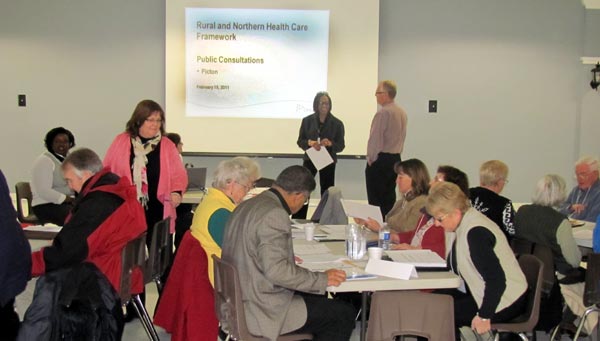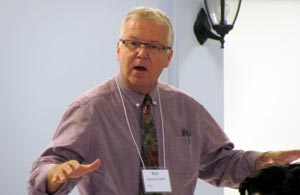Attendance of 53 ‘a huge turnout’ for health care consultation
Administrator | Feb 15, 2011 | Comments 0
 By Prince Edward County standards, attendance was low at the Ministry of Health’s Rural and Northern Health Care public consultation in Picton from 1-3:30 p.m. today, but Rick Johnson was thrilled with the turnout of 53 people saying “it was the second largest to date” – with just two more meetings this week. Most of the meetings, he said, had 8-10 people in attendance.
By Prince Edward County standards, attendance was low at the Ministry of Health’s Rural and Northern Health Care public consultation in Picton from 1-3:30 p.m. today, but Rick Johnson was thrilled with the turnout of 53 people saying “it was the second largest to date” – with just two more meetings this week. Most of the meetings, he said, had 8-10 people in attendance.
 Johnson, MPP for Haliburton-Kawartha Lakes-Brock, is tasked with leading the public consultations which are stage two of the development of a framework to provide “a health care system that provides appropriate access and equitable outcomes for rural, remote and northern Ontario.”
Johnson, MPP for Haliburton-Kawartha Lakes-Brock, is tasked with leading the public consultations which are stage two of the development of a framework to provide “a health care system that provides appropriate access and equitable outcomes for rural, remote and northern Ontario.”
To focus planning efforts, Johnson said the “RuNor” Panel identitied nine guiding principles: Community Engagement; Flexible Local Planning and Delivery; Culturally and Linguistically Responsive; Value; Integration; Innovation; Connected and Co-ordinated; Evidence-Based and Sustainable.
In support of the vision for appropriate access and equity of outcomes the panel proposed the following planning standards and decision guides:
– 90% of residents in a community or local hub will receive primary care within 30 minutes travel time from their place of residence
-90% of residents in a community or local hub will receive emergency services (24/7/52) within 30 minutes travel time from their place of residence
-90% of residents in a community or local hub will receive basic inpatient hospital services within one hour travel time from their place of residence
-90% of residents in a community or local hub will receive speciality inpatient hospital and tertiary diagnostic services within four hours travel time from their place of residence. (Kingston is PEC’s hospital for tertiary services).
“They propose standards and planning guides, then give the caveat that these are to be considered “visionary” and not guidelines in the sense of rules that would set minimum standards or guide service and infrastructure planning,” says Natalie Mehra, Director, Ontario Health Coalition (see story below). “The caveat in the preamble renders this list — which contains some of the best and most concrete recommendations in the report — meaningless. In particular, the access to primary, emergency and tertiary guidelines seem sound. However, the recommendation that inpatient care should be within one hour driving time of peoples’ residences could endanger the future of rural hospitals all across mid-and southern-Ontario.”
Each consultation session is set up to allow for group discussions on a specific set of questions. Attendees are provided a short outline on the panel’s report. The groups are to engage in discussions on a series of questions and specific groups will be asked to present their thoughts and opinions.
The media was asked to leave the discussion portion of the meeting “to allow the attendees to speak freely.”
Johnson said that at the end of each consultation session the comments are collected and notes are made for use in the development of the Rural and Northern Health Care Framework.
Picton’s was the 10th meeting of 12 scheduled in the 14 LHINs (Local Health Integration Network) areas. Two of the LHINs do not contain rural areas.
Executive Summary and recommendations from the Panel’s report click here
If you would like to provide feeback:
phone 1-800-503-8654
TTY 1-800-387-5559
www.ontario.ca/ruralnorthernhealth
Mail: Minister of Health and Long-Term Care
Attention: Rural and Northern Panel Consultations
10th Floor, Hepburn Block
80 Grosvenor Street
Toronto, ON M7A 2C4
Tell government what Picton hospital means to you
 In response to the protest held at Queens Park more than a year ago to stop the closure of small and rural hospitals across Ontario, the government is now holding public consultations on its findings.
In response to the protest held at Queens Park more than a year ago to stop the closure of small and rural hospitals across Ontario, the government is now holding public consultations on its findings.
The meeting Tuesday Feb. 15th from 1-3:30pm at the Prince Edward County Community Centre will allow people to express how much their local hospital means to the community, what gaps in services you are experiencing or see around you, and what changes you would like to see.
Natalie Mehra, Director, Ontario Health Coalition, says the government has scheduled the first of its public hearings on its rural and northern health care report.
She shares a summary of the report and strongly encourages widespread participation.
For the government’s report, etc. go to:
http://www.health.gov.on.ca/en/public/programs/ruralnorthern/consultations.aspx
Ontario Health Coalition
Summary & Notes on Rural and Northern Framework
Stage 1 Report of the Minister’s Panel
(Ontario Ministry of Health and Long Term Care)
The report focuses on access to care.
The Panel states that access must be considered when pursuing other quality of care initiatives.
The report also focuses on geography and proximity to services.
The stated goal is equitable health outcomes.
Mehra notes: “The focus on access may sound elementary, but it is far from given in the current planning of health care services in Ontario. So the focus on access is positive, as is the strong recommendation that access must be considered when pursuing other quality of care initiatives.
The panel defines rural as an area with population <30,000 more than 30 minutes drive from a centre with >30,000 population.
Northern is defined as north of Parry Sound.
Remote is defined as communities without year-round road access.
Findings on health status in rural, remote and northern Ontario:
– lower life expectancy
– higher mortality
– poorer health status
– greater rates of obesity
The Panel’s proposed vision:
“A health care system that promotes appropriate access and achieves equitable outcomes for rural, remote and northern Ontarians”
Mehra says they have defined what they propose as appropriate access in their planning guidelines, “but the MOHLTC could take the vision and ignore the planning guidelines. So it is weak not to more clearly articulate what they mean by appropriate access. Nowhere in the report does the panel refer to the guiding principles of the Canada Health Act.”
Their proposed guiding principles:
Community engagement
Flexible local planning and delivery
Culturally and linguistically responsive
Value
Integration
Innovation
Connected and Coordinated
Evidence-based
Sustainable
“Though the report states that it focuses on access, access is not included in the guiding principles. “Community engagement” is a dubious (and to-date under this government) euphemistic term that is less than democracy and accountability, but it is never clear how much less. Though the committee proposes some standards later, there is no mention of any minimum standard or expected level of care that rural, northern or remote Ontarians should have in the principles. The principles of the Canada Health Act are missing. Among the missing principles are things like: non-profit and public, public interest, accessible, comprehensive, portable, responsive, etc. This is a very technocratic list, reflecting the make-up of the panel.
“They state that their principles are in keeping with the province’s broad vision for health care that is:
Help people stay healthy
Deliver quality care when and where they need it
Ensure sustainability for future generations
“The provincial government’s broad vision for health care listed here might come from the MOHLTC secret document that contains the 10-year health plan for the province. It is not in any other document that I can find. The government refused public release of this document to Elizabeth Whitmer, using “cabinet documents” loophole in FIPPA. It is notable that the principles of the Canada Health Act, and public accountability, democracy, etc., are not in the province’s broad guidelines.
“They propose standards and planning guides, then give the caveat that these are to be considered “visionary” and not guidelines in the sense of rules that would set minimum standards or guide service and infrastructure planning.[1]
– 90% of people in a community or local hub shall receive primary care within 30 minutes of their residence (measured by driving time)
– 90% of people in a community or local hub shall receive emergency services within 30 minutes of their residence
– 90% of people in a community or local hub shall receive inpatient care within 1 hour of their residence
– 90% of people in a community or local hub shall receive specialty inpatient care and tertiary diagnostics within 4 hours of their residence
“The caveat in the preamble renders this list — which contains some of the best and most concrete recommendations in the report — meaningless. In particular, the access to primary, emergency and tertiary guidelines seem sound. However, the recommendation that inpatient care should be within one hour driving time of peoples’ residences could endanger the future of rural hospitals all across mid-and southern-Ontario.”
The Panel’s 12 Recommended strategies with Mehra’s notes:
Create a single point of leadership accountability within the MOHLTC for leading the definition and monitoring standards for rural northern and remote access.
Note: This is the only point under the heading “governance”. Does not include any recommendations re: elimination of local control over hospitals, elimination of democratic processes, public consultation, access to information, eradication of local councils from hospital boards, etc. Lists particulars that this single point of leadership accountability should do to carry the rural remote and northern perspective through MOHLTC work, missing infrastructure planning.
Establish a process to identify strategies to improve access for aboriginal and First Nations’ access to health.
Note: Not sure how this impacts current arrangements for aboriginal and First Nations.
Innovative models for health human resource strategies.
Note: lists a few specifics, generally aligned with our recommendations. Nothing new in the specifics that would deal with the crisis levels of shortages. Their recommendations are less than ours on this issue.
Increase integration of EMS with health planning and delivery at the LHIN and provincial levels.
Ditto public health.
Support a “local hub” model of planning and delivery that integrates services across health sectors at the local or multi-community level and includes broader social services where feasible.
Sub-recommendations include community “engagement” and leveraging small facilities and their catchment areas as local hubs and determine the appropriate balance of services close to home versus in local/community hubs or provincial/LHIN-level resources.
Establish clear roles and responsibilities and supporting infrastructure for health providers that fosters collaboration, defines rural networks and pathways, and coordinates access to services.
Sub-recommendations include LHIN-based and cross-LHIN referral pathways and networks and telemedicine hubs.
Establish formal provincially-coordinated networks for referral and outreach between academic health care centres and local providers in rural, remote and northern communities.
Improve community engagement and participation in decision-making process for planning, funding and delivery to improve dialogue between the LHIN, community and providers.
Sub-recommendations include improve assessment of community health access needs ( Note: no specifics on how to do this)
Conduct a review of inter-facility transfers and transportation to improve planning, coordination and funding.
Conduct a review with the goal of enhancing community-based non-urgent transportation solutions as part of access initiatives.
Sub-recommendations include better alignment of EMS with service planning (Note: no specifics on how to do this), review of travel grants programs, review of funding and use of human resources in inter-facility transfers.
Improve provincial information management and technology availability (eg. eHealth, telemedicine, simulation learning) and provide incentives to encourage use.
[1] There are two notable caveats in this report in which the caveat partially or wholly negates the panel’s recommendation. This is one of them. The other is in the preamble to recommendation #9 which calls for improved community consultation and ownership.
Filed Under: Featured Articles
About the Author:
































